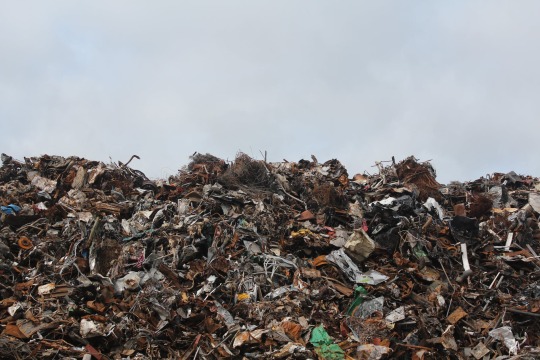#WASTE-TO-ENERGY
Text

Waste-to-energy facility in metro Vancouver.
11 notes
·
View notes
Text
Waste-to-Energy Market Projected to Attain a Valuation of US$ 43.1 Billion by 2031
The waste-to-energy market is witnessing substantial growth momentum driven by the increasing focus on sustainable waste management practices, renewable energy generation, and regulatory initiatives worldwide. With advancements in technology and growing environmental concerns, the market for converting waste into energy is poised for significant expansion in the forecast period of 2023-2031.
The global waste-to-energy market stood at US$ 26.8 billion in 2022 and is projected to reach US$ 43.1 billion in 2031. The global waste-to-energy market is anticipated to expand at a CAGR of 6.1% between 2022 and 2031.
Waste-to-energy (WTE) is a process of generating energy from waste and reducing the dependence on fossil fuels, such as coal, for energy generation. Countries across the globe are investing in renewable energy sources to reduce reliance on fossil fuels. Favorable incentives and schemes have been introduced across all regions to promote effective waste collection and processing, creating significant opportunities for the waste-to-energy industry.
Request Sample of the Report: https://www.transparencymarketresearch.com/sample/sample.php?flag=S&rep_id=633
Market Segmentation:
By Service Type: Waste Collection & Transportation, Waste Treatment, Energy Generation
By Sourcing Type: Municipal Solid Waste, Industrial Waste, Agricultural Waste, Others
By Application: Electricity Generation, Heat Generation, Combined Heat and Power (CHP)
By Industry Vertical: Residential, Commercial, Industrial, Agricultural
By Region: North America, Europe, Asia Pacific, Latin America, Middle East & Africa
Regional Analysis:
North America: Leading the waste-to-energy market with advanced infrastructure, supportive regulatory frameworks, and increasing adoption of renewable energy solutions.
Europe: Strong government initiatives promoting waste management and renewable energy generation, coupled with stringent emission standards driving investments in WtE technologies.
Asia Pacific: Witnessing rapid urbanization and industrialization, leading to a surge in waste generation and increasing demand for sustainable waste management solutions.
Market Drivers and Challenges:
Drivers: Growing waste generation, increasing energy demand, stringent environmental regulations, government incentives for renewable energy projects, technological advancements in WtE technologies.
Challenges: High initial investment costs, public perception and acceptance of WtE facilities, availability of feedstock, regulatory uncertainties, concerns about emissions and air quality.
Market Trends:
Advanced Conversion Technologies: Adoption of advanced technologies such as gasification, pyrolysis, and anaerobic digestion for efficient conversion of waste into energy with reduced emissions and improved efficiency.
Integrated Waste Management Systems: Integration of waste to energy facilities with recycling and composting facilities to achieve a circular economy approach and maximize resource recovery.
Decentralized WtE Facilities: Emergence of small-scale and decentralized waste-to-energy plants catering to localized waste management needs and reducing transportation costs.
Future Outlook: The waste-to-energy market is expected to witness significant growth in the coming years, driven by increasing waste volumes, energy demand, and environmental concerns. Technological innovations, supportive regulatory frameworks, and public-private partnerships are expected to play key roles in shaping the future of the WtE industry.
Key Market Study Points:
Assessment of waste generation trends and composition analysis across different regions and industry sectors
Analysis of regulatory policies and incentives influencing the adoption of waste to energy technologies
Techno-economic evaluation of WtE projects, including investment costs, operational efficiency, and revenue generation potential
Environmental impact assessment of WtE facilities, including emissions monitoring and air quality management
Market dynamics influencing feedstock availability, energy prices, and
competitive landscape
Competitive Landscape: The waste to energy market is characterized by the presence of key players such as Covanta Energy Corporation, Veolia Environnement S.A., Suez Environment S.A., and Waste Management, Inc. These companies are actively engaged in technological innovation, strategic partnerships, and expansion initiatives to capitalize on the growing demand for sustainable waste management and renewable energy solutions.
About Transparency Market Research
Transparency Market Research, a global market research company registered at Wilmington, Delaware, United States, provides custom research and consulting services. Our exclusive blend of quantitative forecasting and trends analysis provides forward-looking insights for thousands of decision-makers. Our experienced Analysts, Researchers, and Consultants use proprietary data sources and various tools & techniques to gather and analyze information.
Our data repository is continuously updated and revised by a team of research experts so that it always reflects the latest trends and information. With a broad research and analysis capability, Transparency Market Research employs rigorous primary and secondary research techniques in developing distinctive data sets and research material for business reports.
Contact:
Transparency Market Research Inc.
CORPORATE HEADQUARTER DOWNTOWN,
1000 N. West Street,
Suite 1200, Wilmington, Delaware 19801 USA
Tel: +1-518-618-1030
USA - Canada Toll-Free: 866-552-3453
Website: https://www.transparencymarketresearch.com
0 notes
Text

Waste Gas Fired Boilers Redefining Green Energy Solutions
Thermodyne we proudly introduce our cutting-edge Waste Gas Fired Boiler, a technological masterpiece that exemplifies sustainability and efficiency in the field of industrial heating solutions. Our waste gas-fired boilers, meticulously crafted with both precision and environmental consciousness, effortlessly convert industrial waste gases into a valuable energy source, minimizing environmental impact and operational expenses. Thermodyne's Waste Gas Fired Boiler stands as a beacon of innovation, providing a clean and environmentally friendly option for industries seeking dependable heating solutions.
#Waste Gas Boiler#Waste-to-Energy#Sustainable Energy#Green Technology#Environmental Efficiency#Energy Innovation
0 notes
Link
0 notes
Text
Bio-Energy Market Report, Research Outlook, Products, and Application 2017 – 2032

Overview of the Bio-Energy Market:
The production, delivery, and use of energy obtained from biomass resources are all part of the bioenergy market. The term "biomass" refers to organic materials that can be used to create energy through a variety of processes, such as combustion, gasification, and biochemical conversion, such as plants, agricultural residues, forestry residues, and organic waste. Biomass may be refilled through sustainable practises, which is why bioenergy is regarded as a renewable energy source.
The global bioenergy market size was valued at $102.5 billion in 2020, and is expected to reach $217.8 billion by 2030, registering a CAGR of 7.6% from 2021 to 2030.
Key Factors Driving the Bio-Energy Market:
Transition to Renewable Energy: The bioenergy sector is significantly influenced by the global move to renewable energy sources. As a renewable and environmentally friendly substitute for fossil fuels, bioenergy helps to slow global warming by lowering greenhouse gas emissions.
Energy Independence and Security: By utilising a variety of energy sources, bioenergy can help with energy security. Countries with plentiful biomass resources can increase their energy independence and decrease their reliance on imported fossil fuels.
Government Policies and Incentives: Countless countries around the world have put policies and incentives in place to encourage the use of bioenergy. These policies stimulate the creation and application of bioenergy technology and include feed-in tariffs, renewable energy objectives, tax incentives, and subsidies.
Concerns for the environment and carbon neutrality: Bioenergy is regarded as a carbon-neutral energy source because the carbon dioxide.
Waste Management and Circular Economy: Bio-energy can play a role in waste management by utilizing organic waste materials for energy production. This contributes to the circular economy concept, where waste is seen as a resource, promoting sustainable resource utilization and waste reduction.
Technological Advancements and Efficiency Improvements: Advances in bio-energy technologies, such as improved biomass conversion processes, biofuel production techniques, and efficient combustion systems, enhance the efficiency and economic viability of bio-energy. Technological advancements make bio-energy more competitive and attractive in the energy market.
Regional Variations in Biomass Resource Accessibility: There are regional differences in the accessibility and availability of biomass resources. Countries with an abundance of biomass resources, such as forestry waste and agricultural wastes, provide favourable conditions for the development of bioenergy.
Rural Development and Job Creation: By generating jobs in the biomass production, processing, and bioenergy plant operations, bioenergy initiatives frequently have a favourable effect on rural regions. Rural development and economic expansion are aided by this.
We recommend referring our Stringent datalytics firm, industry publications, and websites that specialize in providing market reports. These sources often offer comprehensive analysis, market trends, growth forecasts, competitive landscape, and other valuable insights into this market.
By visiting our website or contacting us directly, you can explore the availability of specific reports related to this market. These reports often require a purchase or subscription, but we provide comprehensive and in-depth information that can be valuable for businesses, investors, and individuals interested in this market.
“Remember to look for recent reports to ensure you have the most current and relevant information.”
Click Here, To Get Free Sample Report: https://stringentdatalytics.com/sample-request/bio-energy-market/11393/
Market Segmentations:
Global Bio-Energy Market: By Company
• Abengoa Bioenergy
• Amyris
• BP
• Butamax Advanced Biofuels
• Ceres
• Enerkem
• Joule Unlimited
• LanzaTech
• Novozymes
• Sapphire Energy
Global Bio-Energy Market: By Type
• Bioethanol
• Biodiesel
• Biogas
• Others
Global Bio-Energy Market: By Application
• Transportation
• Off-grid Electricity
• Cooking
• Others
Global Bio-Energy Market: Regional Analysis
The regional analysis of the global Bio-Energy market provides insights into the market's performance across different regions of the world. The analysis is based on recent and future trends and includes market forecast for the prediction period. The countries covered in the regional analysis of the Bio-Energy market report are as follows:
North America: The North America region includes the U.S., Canada, and Mexico. The U.S. is the largest market for Bio-Energy in this region, followed by Canada and Mexico. The market growth in this region is primarily driven by the presence of key market players and the increasing demand for the product.
Europe: The Europe region includes Germany, France, U.K., Russia, Italy, Spain, Turkey, Netherlands, Switzerland, Belgium, and Rest of Europe. Germany is the largest market for Bio-Energy in this region, followed by the U.K. and France. The market growth in this region is driven by the increasing demand for the product in the automotive and aerospace sectors.
Asia-Pacific: The Asia-Pacific region includes Singapore, Malaysia, Australia, Thailand, Indonesia, Philippines, China, Japan, India, South Korea, and Rest of Asia-Pacific. China is the largest market for Bio-Energy in this region, followed by Japan and India. The market growth in this region is driven by the increasing adoption of the product in various end-use industries, such as automotive, aerospace, and construction.
Middle East and Africa: The Middle East and Africa region includes Saudi Arabia, U.A.E, South Africa, Egypt, Israel, and Rest of Middle East and Africa. The market growth in this region is driven by the increasing demand for the product in the aerospace and defense sectors.
South America: The South America region includes Argentina, Brazil, and Rest of South America. Brazil is the largest market for Bio-Energy in this region, followed by Argentina. The market growth in this region is primarily driven by the increasing demand for the product in the automotive sector.
Click Here, To Buy Premium Report: https://stringentdatalytics.com/purchase/bio-energy-market/11393/?license=single
Reasons to Purchase Bio-Energy Market Report:
• To gain insights into market trends and dynamics: this reports provide valuable insights into industry trends and dynamics, including market size, growth rates, and key drivers and challenges.
• To identify key players and competitors: this research reports can help businesses identify key players and competitors in their industry, including their market share, strategies, and strengths and weaknesses.
• To understand consumer behaviour: this research reports can provide valuable insights into consumer behaviour, including their preferences, purchasing habits, and demographics.
• To evaluate market opportunities: this research reports can help businesses evaluate market opportunities, including potential new products or services, new markets, and emerging trends.
• To make informed business decisions: this research reports provide businesses with data-driven insights that can help them make informed business decisions, including strategic planning, product development, and marketing and advertising strategies.
About US:
Stringent Datalytics offers both custom and syndicated market research reports. Custom market research reports are tailored to a specific client's needs and requirements. These reports provide unique insights into a particular industry or market segment and can help businesses make informed decisions about their strategies and operations.
Syndicated market research reports, on the other hand, are pre-existing reports that are available for purchase by multiple clients. These reports are often produced on a regular basis, such as annually or quarterly, and cover a broad range of industries and market segments. Syndicated reports provide clients with insights into industry trends, market sizes, and competitive landscapes. By offering both custom and syndicated reports, Stringent Datalytics can provide clients with a range of market research solutions that can be customized to their specific needs
Contact US:
Stringent Datalytics
Contact No - +1 346 666 6655
Email Id - [email protected]
Web - https://stringentdatalytics.com/
#Bioenergy#Renewable Energy#Biomass#Biofuels#Biogas#Bioethanol#Biodiesel#Waste-to-Energy#Sustainable Energy#Carbon Neutrality#Energy Production#Green Energy#Biomass Conversion#Feedstock#Energy Crops#Anaerobic Digestion#Cogeneration#Bioenergy Technologies#Bioenergy Applications#Biomass Power Plants#Bioenergy Industry#Bioenergy Market Trends#Bioenergy Policy#Bioenergy Investments#Bioenergy Economics#Bioenergy Sustainability#Bioenergy Advantages#Bioenergy Challenges#Biomass Supply Chain#Bioenergy Infrastructure
0 notes
Text
One thing I’ve noticed about people in or entering their 30s is they don’t make as many compromises anymore. If someone doesn’t meet them halfway, is not up to standard, is just not where they’re needed to be, they’re just like “ok cool” and they move on from the person. Which is not to say they’re less empathetic or understanding, but more that they have learned that time is their most prized possession and they’re not willing to make massive compromises on it. They are not obsessed w the idea of fixing someone (bc the concept of fixing a person doesn’t really exist). They simply move on to someone who is up to par. I want that. I want to always move w the awareness that time is my most priceless belonging and I can never buy it back. Ever. So I have to use it wisely
#not just when it comes to ppl but w opportunities too!#w not wasting your energy on negativity#w always seeing the big picture etc etc#i just want to always move from a place of ‘is this expending time that could be best spent elsewhere?’#just a note 2 self while I navigate how to spend my time#which includes dedicated studying & reading more consistently & moving my body & enjoying nature & telling someone I love them <3#we will be alright#text
9K notes
·
View notes
Text
Trash No More: Meet the Tech That Transforms Waste Into Renewable Energy
Waste-to-energy technologies revolutionize the waste management landscape, offering sustainable and eco-friendly solutions. These innovative systems can transform organic waste, which is often seen as a problem, into valuable renewable energy sources like biogas and electricity. By turning trash into treasure, waste-to-energy facilities not only address the global waste crisis but also contribute…

View On WordPress
#biogas#clean energy#eco-friendly#green energy#green technology#India#methane#organic waste#pollution#sustainability#Sweden#trash#waste management#waste-to-energy
0 notes
Text
Garbage Incineration: What are we Waiting For?
Are you for or against garbage incineration? I am a huge proponent of the theory and practice, so encouraged to hear it is being discussed here in Ottawa.
It has been proven to be efficient and successful in many advanced countries around the world, including Switzerland, Norway, Belgium, France, Denmark, and the USA. Canadian cities with success in waste-to-energy include Durham-York and…

View On WordPress
#Allan Hubley#bandaid fix#councillor#David Brown#Durham York Energy Centre#Durham-York#Inciner8#MordorIntelligence#Nature.com#waste-to-energy#Western Investor#WTE
0 notes
Text


double black
#lotus try to go one day without thinking abt skk challenge (IMPOSSIBLE)#also poses in the first img are referenced from thegrayninja on deviantart!!#nobody in this fandom draws chuuya just constantly floating around as opposed to walking and i think thats a crime#if you think a 15yo boy w gravity powers wouldn't absolutey abuse the shit out of that ability and just refuse to walk#then you're wrong. and you know it.#ik for a fact my lazy ass would take advantage of the fact that i could just move freely in the air and not have to waste energy walking#wish dazai didn't have nullification bc then chuuya could pick him up and they could recreate the hmc scene (chuuya would drop him /hj)#bungou stray dogs#bungo stray dogs#bsd#chuuya nakahara#nakahara chuuya#dazai osamu#osamu dazai#soukoku#skk#lotus draws
4K notes
·
View notes
Text






so this episode is off to a smashing start
#pun FULLY intended#holy shit the chaotic energy is absolutely top notch#lou wasted NO TIME#i love this fucking show#i have said it before and i will say it again#lou wilson DOES NOT FUCK AROUND#game changer#d20#dimension 20#college humor#dropout#dropout tv#siobhan thompson#lou wilson#brennan lee mulligan#game changer spoilers#sam reich#andis thought geyser
17K notes
·
View notes
Text
Had this Headcannon that when Multi-Lingual Dick and Jason get drunk they start singing Ballads in Spanish. Yeah some classical shit like Vicente Fernandez but also the most wild Selena you've ever heard.
#is this a post about Latinx Jason todd? Bitch it might be#Don't ask me about it tho cuz I'll deny it to my core#I imagine jason drunk off his ass belting No Me Queda Mas like he fuckin wrote the song#Dick's got Como la Flor Energy but he has ugly Sobbed NMQS too#they are so infamous for their drunk spanish ballads that they actually rub off on TIm#imagine young justice suprise when the whitest kid you've ever seen wasted on 7/11 liquor is hiccuping his way through a selena song#worst accent you've ever heard sounds like a dog from New Jersey learning to bark and yet the emotion is kinda on point#TIm denies it#refuses to believe he has ever done it#Dick and Jason get a copy of the video and someone edits a mash up of all three of them warble singing that banger#anyway this was a nothing post of nothing I made for myself#fr just for me#DC#Batman#Batfam#Jason todd#Tim drake#Dick Grayson
2K notes
·
View notes
Text
im so fucking useless
#all I do is consume without contributing anything to society#i feel so guilty for eating breathing taking up space buying things producing trash wasting people's time and energy#literally my existence has no meaning#why am i alive#literally w.o.r.t.h.l.e.s.s.#tw depressive#tw depressing thoughts#tw depression#depressing shit#sorry for being depressing#im exhausted#i hate everything#i hate my self#more than anyone else#i dread having to exist#self h@te#i'm sad#mentally tired#vent#venting#personal
732 notes
·
View notes
Text
You live a better life when you just accept that your comfort character fucking sucks and there's no sympathetic reason or justification for their shitty behaviour, people are flawed, and you look kinda silly when you break your back to try to excuse your favourite character's cruel decisions.
Your favourite character is a hopeless fuckhead sometimes
#it's not worth the energy man#the world is a dark fucking place#don't waste your free time to be mad about shit like this#embrace the shit
845 notes
·
View notes
Text

Transforming Waste into Energy: The Waste Gas Boiler
Thermodyne Engineering System, we take pride in presenting our innovative solution to energy needs – the Waste Gas-Fired Boiler. Our Waste Gas-Fired Boiler is designed to harness waste gases and convert them into a valuable source of energy. It's a testament to our commitment to providing valuable content to the industry. By integrating cutting-edge technology and sustainable practices, we've created a solution that not only optimizes resource utilization but also reduces environmental impact with Thermodyne's Waste Gas-Fired Boiler, you're not just investing in a boiler; you're investing in a greener, more efficient future for your business. For more information contact us at https://www.thermodyneboilers.com/wastetherm/
#Waste Gas-Fired Boiler#Boiler Manufacturer#Efficiency and Sustainability#Industrial Boilers#Energy Efficiency#Waste-to-Energy
0 notes
Text
The Architecture of Rain World: Layers of History
A major theme in Rain World's world design that often goes overlooked is the theme of, as James Primate, the level designer, composer and writer calls it, "Layers of History." This is about how the places in the game feel lived-in, and as though they have been built over each other. Here's what he said on the matter as far back as 2014!

The best example of this is Subterranean, the final area of the base game and a climax of the theme. Subterranean is pretty cleanly slpit vertically, there's the modern subway built over the ancient ruins, which are themselves built over the primordial ruins of the depths. Piercing through these layers is Filtration System, a high tech intrusion that cuts through the ground and visibly drills through the ceiling of the depths.
Two Sprouts, Twelve Brackets, the friendly local ghost, tells the player of the "bones of forgotten civilisations, heaped like so many sticks," highlighting this theme of layering as one of the first impressions the player gets of Subterranean. Barely minutes later, the player enters the room SB_H02, where the modern train lines crumble away into a cavern filled with older ruins, which themselves are invaded by the head machines seen prior in outskirts and farm arrays, some of which appear to have been installed destructively into the ruins, some breaking through floors.


These layers flow into each other, highlighting each other's decrepit state.
The filtration system, most likely the latest "layer," is always set apart from the spaces around it. At its top, the train tunnels give way to a vast chasm, where filtration system stands as a tower over the trains, while at the bottom in depths, it penetrates the ceiling of the temple, a destructive presence. (it's also a parallel to the way the leg does something similar in memory crypts, subterranean is full of callbacks like that!)


Filtration system is an interesting kind of transition, in that it is much later and more advanced than both of the areas it cuts between. This is a really interesting choice from James! It would be more "natural" to transition smoothly from the caves of upper subterranean to the depths, but by putting filtration system in between, the two are clearly demarcated as separate. The difference in era becomes palpable, the player has truly found something different and strange.
Depths itself is, obviously, the oldest layer not only of subterranean but of the game itself. The architecture of Depths has little to do with the rest of the game around it, it's a clear sign of the forgotten civilisations that our friend Two Sprouts, Twelve Brackets showed us, there's not actually that much to say about it itself, it's mostly about how it interacts with the other layers of subterranean.
That said, Subterranean is far from the only case of the theme of layers of history. It's present as soon as the player starts the game!
The very first room of the game, SU_C04, is seemingly a cave. It is below the surface, the shapes of it are distinctly amorphous rather than geometric. (well. kind of, it doesn't do a very good job of hiding the tile grid with its 45 degree angles.)

But let's take a closer look, shall we?

See that ground? it's made of bricks. The entire cave area of outskirts is characterised by this, the "chaotic stone" masonry asset is mixed with brickwork, unlike the surface ruins which are mostly stone. This, seemingly, is an inversion of common sense! The caves are bricks and the buildings are stone. This is not, however, a strange and unique aspect but a recurring motif.


This occurs enough in the game for it to be clearly intentional, but why would materials such as bricks be used in otherwise natural looking terrain?
The answer lies in the "Layers of History" theme. This is in fact, something that happens in real life, and it's called a tell
To be specific, a tell is a kind of mound formed by settlements building over the ruins of previous iterations of themselves. Centuries of rubble and detritus form until a hill grows from the city. Cities such as Troy and Jericho are famous examples. The connections to the layers of history theme are pretty clear here, I think. Cities growing, then dying, then becoming the bedrock of the next city. The ground, then, is made of bricks, because the ground is the rubble of past buildings. The bones of forgotten civilisations, heaped like so many sticks!
#rain world#rainworld#rain world lore#rainworld lore#rw lore#rw#subterranean my beloved#thank you to videocult for making the first survival game themed around stratigraphy and new york city rats#i would've gone on for another paragraph about how OE relates to this but like.#that's dlc stuff#and i still think of the dlc stuff as modded content lol#better to keep it separate#also this analysis is not comprehensive! the layers of history stuff is common throughout#there's farm arrays there's the relationship between shaded citadel and five pebbles there's the stuff buried under garbage wastes#so much more#unfortunately i do not have much energy lol
637 notes
·
View notes
Text





you guys i am so in love with this fandom. you people read 2 whole books about a solar system with 9 planets that is stated to have been the cradle of humanity and you are still surprised when it turns out that it’s like, THE solar system.
Just fully no thoughts, head empty, marinating in the lesbianism of the situation without a single neuron firing. i salute your dedication
#i'm not trying to throw shade i am genuinely amazed#in AWE even#i figured that it was the solar system the first time they said nine houses but i am realizing that makes me the fool here#u guys were having fun without knowing that so clearly i wasted my energy#i feel bad for even tagging that as a spoiler but i WILL do it anyway#tlt#tlt spoilers#gideon the ninth#gideon nav#tlt series#harrowhark nonagesimus#harrow the ninth#gideon the ninth spoilers#griddlehark#tlt shitposting
7K notes
·
View notes